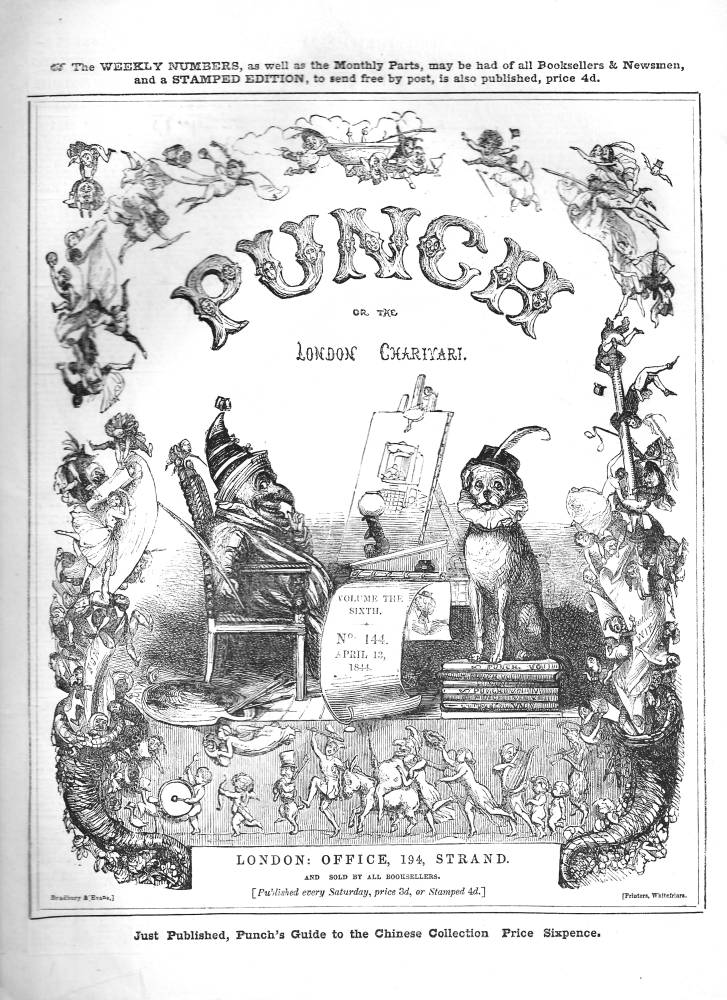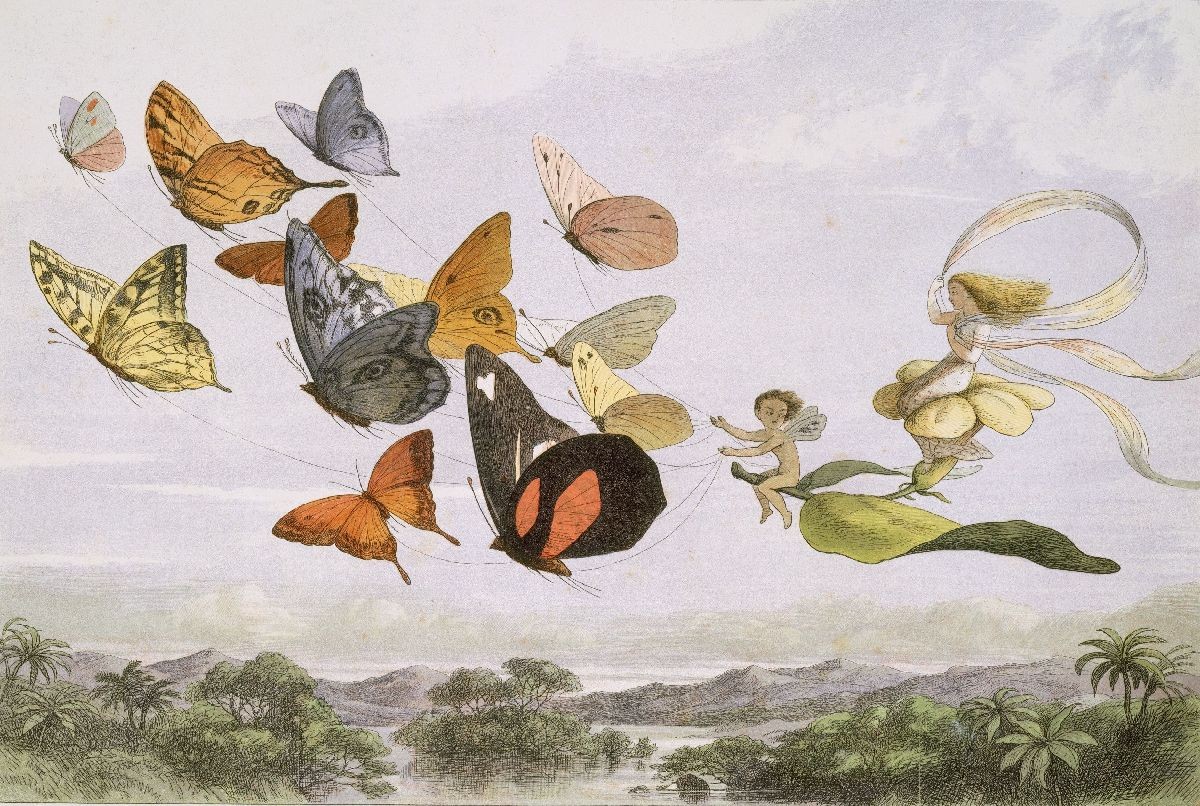Walking in Fairyland
“Well, what are you going to say about Doyle? He’s probably the best of them all. He’s sensational. He has all the accouterments of the Victorian illustrator—the girls look right, for example—but he’s one of the better draftsmen, he had the cleverest mind, the most gorgeous sense of color, and a fantastic imagination. . . . He is just one of the super artists, and you don’t have to know what it is he’s doing. It doesn’t have to be spelled out, it really doesn’t. The fact that it works and that it conveys itself instantly to you—that’s what illustration is all about”
— Maurice Sendak
Richard “Dicky” Doyle was among the most celebrated illustrators of the Victorian era. Considered an heir to George Cruikshank, Doyle’s artistic range encompassed social satire and depictions of fairies and fantasy. His work is defined by his lively and delicate touch. This is seen in his work at Punch in the 1840s. At Punch, he created one of his most recognizable works, the magazine’s masthead, which was used for over a century. But his masterpiece, “In Fairyland”, an illustrated book clearly for children, also resonated with adults, subtly addressing adult themes. The book was produced with luxurious detail. It includes intricate wood engravings by Edmund Evans. It set new standards in book production, especially for picture books.
Dicky was born in September 1824 in London to a wealthy Catholic family. His father was the renowned Irish cartoonist John Doyle, whose satirical prints were influential during the 1820s and 1830s. Richard was one of seven children, with all three surviving brothers also gifted artists. Despite his talented family, Richard stood out as exceptionally gifted. Educated at home by his father, Dicky Doyle displayed advanced talent from an early age.
victorian web the doyle family
illustration history richard doyle
dictionary of irish biography richard doyle
A journal entry by Dicky reads that he was kept awake at night by visions of fairies and puckish gnomes, and he filled his sketchbooks with “elves … sylphs and grotesque monsters which explode from doorways or swirl through the clouds in intricate layers.” Blessed with a vivid imagination and taught by his father led Dicky to become a very talented artist from a young age.
jonkers rare books richard doyle
Early Punch
In 1843, aged 19, Richard Doyle joined Punch magazine, starting with small tasks and occasional contributions. Over seven years, he became a major comic artist. He was known for his whimsical ‘Nonsense Style’. Editors liked it for its fantastical charm. Doyle had many chances to show his creativity. He did this through his childhood-inspired drawings. These included a weekly fantasy engraving and full-page political cartoons with John Leech. His biggest achievement at Punch was designing the cover in 1844. It stayed in use until 1954.


Punch, like any magazine, needed a good front cover, to engage and attract readers. Founded in 1841 under Mark Lemon’s editorship. Its early success was uncertain, so it had to define its identity and purpose. It needed to do this to build a customer base that matched readers’ tastes and expectations. It’s the same concept as a packaging label. It engages with its audience. It sets a visual brand and identity. And it conveys its satirical tone.
In the first two years of Punch magazine, the cover was regularly changed by other artists. After these covers failed to satisfy Lemon, he had Richard Doyle work on a more permanent one. Doyle crafted two Punch cover designs, the initial one debuting in 1844. This first design, unlike the earlier ones, was focused and coherent. His second design carried forward the changes made and is the more famous design, being used for over a century.
Doyle’s cover designs for Punch magazine parodied classical art and aesthetics. He incorporated elements such as a neo-classical frieze and figures like Greek revelers. He also added a touch of German rusticity. They were presented in a comical and satirical way. This way aligned with Punch’s spirit. The magazine’s complex ideas and messages were intricately woven into its cartoons. For contemporary audiences, this cover would have been as readable as a modern painting is for us. So, for today’s viewers, understanding this masthead requires much research. They must uncover its meaning. For more information, refer to the Victorian Web’s excellent article on the topic.
illustration history richard doyle
Doyle enjoyed a respected seven-year tenure at Punch. But, he left in November 1850 due to dissent about “papal aggression”. He declined offers from other top magazines. He chose not to work for any publication as good as Punch again.
Life after Punch
Dicky Doyle’s career after Punch focused on freelance design for children’s books. He illustrated works like John Ruskin’s “The King of the Golden River” and Mark Lemon’s “Enchanted Doll.” His friend W.M. Thackeray often hired him for illustrations as well. By his mid-twenties, Dicky struggled with procrastination and dedication to his work. Without regular deadlines and the structure of magazine issues, completing commissions and book illustrations became difficult. For instance, during his collaboration with J.R. Planché on “An Old Fairy Tale Told Anew in Pictures and Verse” in 1865, Doyle showed a series of splendid drawings for “Sleeping Beauty.” However, he did not finish the illustrations, leaving the book incomplete. Doyle had ongoing commissions. But, he often found other distractions, like family obligations and social engagements. These distractions hurt his reputation and output.
And Creating a Masterpiece
George Cruikshank drew black-and-white comics for Edgar Taylor’s German Popular Stories. The book was the first English translation of Grimms’ fairy tales. His drawings are considered pivotal in making fairy tales a respectable form of children’s literature. The fairy tales quickly became popular and one could argue they became the main forms of children’s literature in England in the late 1800s. The Victorian age brought the triumph of the fairy tale. It also brought one of the great periods of book illustration. Victorian fantasy illustration was known for its detailed art and lively characters. It took readers into magical worlds. Richard Doyle, along with Hans Christian Andersen, John Tenniel, and George Cruikshank, achieved widespread acclaim. Their work captured the public’s imagination and influenced the genre’s visuals. Nineteenth-century Britain was a golden age for children’s literature. It was also a time of innovative book design. The two fields were often united.
“One of the finest books ever produced for children, and from the collector’s point of view a most desirable item to add to any library of juvenile works.” Eric Quayle, Collector of Children’s Books
Despite his success in caricatures and cartoons, Doyle is best remembered for his fairy-tale drawings. His breakthrough came in 1846 with “The Fairy Ring.” It drew comparisons to George Cruikshank. Doyle’s fantasy style was great for fairy tales, leading to many commissions in this genre. Richard Doyle’s In Fairyland: A Series of Pictures From the Elf-World is the greatest Victorian book of fairies, Doyle’s masterpiece. The illustrations are bright, personal, and spirited. They depict a fairy world that is still the visual model for modern fairy images. Doyle’s sixteen large vibrant color plates and intricate line illustrations are stunning. They were engraved and printed by Edmund Evans, one of the best printers of the era.
Doyle started In Fairyland in 1868 after his father’s death. He created pencil-and-ink drawings and then transferred them to watercolors. Initially, he envisioned a fairy album featuring his favorite figures. He planned to call the series “Fairyland—Pictures from the World of Fairies, Elves & Goblins, Dwarfs, Sprites.” Longmans, his publisher, said the drawings needed text to connect the images better. So in July 1869, Longmans asked Richard Allingham to write verses for Doyle’s fairy drawings. The book was published in time for the 1869 Christmas season, but dated 1870. It is an immense book with a page size of 14 7 ⁄8 × 10 7 ⁄8 inches. Doyle’s In Fairyland illustrations are complete and stand-alone. They should be seen as part of the Victorian narrative art movement. It was designed as a treasure and priced as such, at 31 shillings and 6d it was far too expensive for all but the most middle-class households. Two thousand were printed. But, records in the Longman Archive (University of Reading, United Kingdom) show that few were sold. This led to the sale of the remainders, which were reissued with a new title page in 1875. Longman also tried a second version of the book with a poem by Andrew Lang.
The book is a pinnacle of Victorian illustration and book design. It shows Doyle’s enchanting fairy world at its best. And upon closer look, the illustrations reveal complexity. The fairies can appear mean, and the story hides an adult allegory. In this work, Doyle explores Victorian views on sex and industry. He does this by examining their dichotomy using subtle and nuanced imagery.
The illustrations of In Fairyland outdo any author’s attempts to control them. This includes the captions by Doyle, Allingham’s poem, Lang’s fairy tale, and various editors’ attempts to abridge them. Doyle’s book illustrations are a landmark for Victorian Era Art and the influence of modern picture books. His brilliant illustrations anticipate the rising importance of the visual in contemporary culture. They form a key transition from Victorian narrative painting to modern picture books, especially the wordless picture book.
andrew lang mixes up richard doyle by jan susina





British Museum Selection of Richard Doyle Work
The King is Coming
During the Victorian era, there was a surge in the production of fairy tales, fantasy, and nonsense. These genres began to appear in small numbers early in Queen Victoria’s reign. They continued to grow throughout the period, gaining more popularity and impact. In the past, children’s literature had mostly served educational or moral purposes. It was presented by primers and/or religious verses. But, in the 19th century, a wide range of literature emerged for young readers. Artists and writers, like Richard Doyle, Hans Christian Andersen, John Tenniel, and George Cruikshank, were key to this change. They made visually enchanting illustrations with rich, vivid imagery. The images accompanied imaginative stories. The illustrations could stand alone. They added to the text by telling stories beyond the letters on the page. Their contributions and the growing demand for more engaging and varied storytelling helped establish a broader audience. They also laid the groundwork for the golden age of picture books that followed. And we must not overlook the lithographic and printing advancements. They were made by Alois Senefelder, George Baxter, and Charles Knight. Soon, we’ll delve into the additions of Edmund Evans. He was a key figure in the printing of rich and intricate illustrations, the same illustrations that would change picture books forever.
More Articles to Read:
victorian chronicles manners of victorian times
the illustrated letters of richard doyle
Thank you,
Caleb




